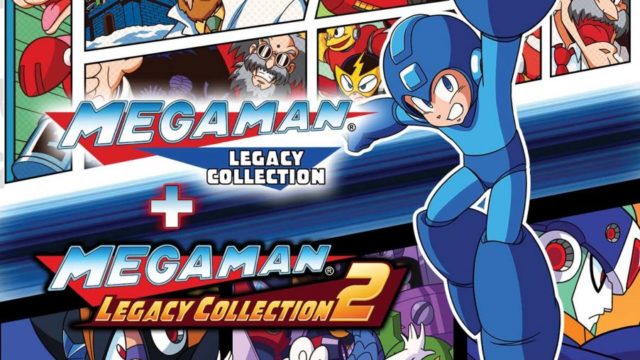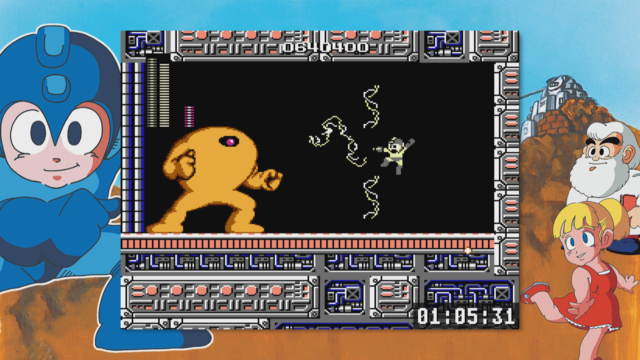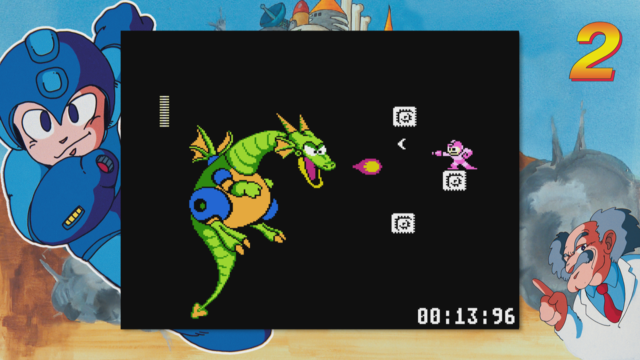Ten Mega Man games in one package, representing some of the greatest platformers ever made; bevy of visual options to go along with the sterling HD presentation; tons of extras like Museum Mode and the Database; improved saving for most of the games; rewind functionality for the first six games lets players erase mistakes without having to replay entire stages; portability of Switch means some of these games are going portable on a Nintendo system for the first time; exquisite play control and level design throughout; Amiibo functionality brings some solid, exclusive content to Switch
Mega Man 7 and Mega Man 8 are weaker selections—fun in their own right, but not as strong as the other eight titles; difficulty will overwhelm some players, even with the quality of life additions like rewind
Oh, Capcom. Who besides Nintendo and maybe Sega has such a robust back catalogue of classic software that it can continue to re-release the same games over and over from one console generation to the next? Not that I’m complaining, of course. Well, not about getting Mega Man Legacy Collection 1 + 2 on Switch, at least. It’s a delightful compilation that brings together a smattering of some of the best platformers ever made, replete with a handful of extras to round things out.
If I have anything to complain about it’s the timing of this compilation’s release. The original Legacy Collection came out back in 2015 on PlayStation 4 and Xbox One, eventually hitting 3DS, and now Switch. The sequel, Legacy Collection 2, also had a head start on the distinguished competitions’ systems. I mention this because the likelihood here is that many of you reading our review might already own both Legacy Collections on different platforms and are wondering, “what’s the point of getting it for Switch?”
Let’s get this out in the open first: for those who don’t own any of the other versions of Legacy Collection 1 + 2, this is a must-buy (and I’ll detail why in a moment). For those who do, I think a double dip isn’t out of the question. What I said above isn’t hyperbole: the Mega Man series represents some of the best that gaming has to offer. Whether playing these titles for the first time or for the first time in a long time, it’s a no-brainer to want Legacy Collection 1 + 2 in your collection. If you’ve already played these two games on other platforms, I’d argue that Switch represents the best iteration of each to date. Both compilations are now portable by being on Switch and there’s Amiibo functionality that other consoles can’t offer. How much those last two bits matter will have varying mileage from person to person, but they’re factors that are definitely worth mentioning.

For the unversed, Legacy Collection 1 + 2 on Switch are two separate games that can either be purchased individually or as a pair. Those who buy the retail physical version of the game will get both, although note that only the first Legacy Collection is on the cartridge; Legacy Collection 2 must be downloaded. Here’s what you get with each compilation:
- Mega Man Legacy Collection
- Mega Man
- Mega Man II
- Mega Man III
- Mega Man IV
- Mega Man V
- Mega Man VI
- Mega Man Legacy Collection 2
- Mega Man VII
- Mega Man 8
- Mega Man 9
- Mega Man 10
In total, that’s ten games! Mega Man through Mega Man VI are all NES titles, Mega Man VII is SNES, Mega Man 8 is PlayStation, and Mega Man 9 and Mega Man 10 are Wii darlings. Along with the base games, there is quite a bit of extra content to enjoy across these two compilations. Museum Mode is exactly what it sounds like, bringing in tow a plethora of historical goodies like concept art, promotional materials, and more. For those who’ve wondered about what went into making Mega Man over all these years, Museum Mode is an invaluable wealth of knowledge. There’s also a Database stuffed with information about the characters and enemies throughout the series. This writer would love to see it all compiled into a book, but I digress!

Challenge Mode, meanwhile, brings remixed versions of classic stages. So, even for series veterans who have busted every boss and collected every bolt that Mega Man has to offer, Challenge Mode provides something entirely new. Players can even compete via online leaderboards to see who can get through a given stage faster than anyone else. One of the things unique to the 3DS and now Switch version of Legacy Collection is Amiibo functionality. Tap either the gold or standard Mega Man Amiibo and extra trials can be unlocked in Challenge Mode.
But wait, there’s more! Putting the average infomercial product to shame, Legacy Collection 1 + 2 has other bells and whistles to impress with. The Rewind function allows players to replay tricky segments and avoid untimely deaths, while a modernized save system in every game means the days of jotting down passwords are in the past. Turbo CPU Speed lets players cut out the slowdown that the NES Mega Man games were so prone to when a flurry of on-screen activity would hit. There are also graphical filters to make the visual fidelity as murkily retro or crisply modern as the user wants. There are also some very nice screen borders to wrap around the playing field, or they can be removed entirely.
Now, before everyone gets too excited, let me make something clear: not all of these features and content are available in both Legacy Collections. The original has every element I just described above, but Legacy Collection 2 does not. There’s no Database to speak of, the rewind functionality is absent, saving is reserved for in-game checkpoints (as opposed to anywhere in the first collection), and there are only four games compared to the six found in its predecessor. Ouch.
It’s also worth noting that Legacy Collection 2 has arguably the weaker arrangement of Mega Man games. Mega Man VII has some sumptuous pixel graphics thanks to the transition to Super Nintendo back in the day, but it was also marred by a strange tweak to level progression (all eight Robot Masters aren’t available from the outset) and character/enemy sprites that feel overly large. This makes the platforming and gunplay in MMVII a bit unwieldy and cumbersome. Mega Man 8, meanwhile, marked the series’ shift to PlayStation, which brought with it some stunning visuals but further problems with play control. MM8 simply doesn’t control as precisely as the NES iterations of the series and suffers, as a result. They are both fun games, but are absolutely the weakest entries.
The saving grace of Legacy Collection 2 comes in the forms of Mega Man 9 and 10. Both titles marked a return to the 8-bit stylings and play control of the NES days of the series and are arguably two of the best games to be cast in that classic mold. Capcom strove to keep MM9 and 10 as period-authentic as possible, but there are notable improvements in color selection and processing capabilities. That said, MM9 is notoriously hard. The lack of a rewind function and more liberal saves is perhaps felt harder here than it is in the original Legacy Collection. Old-school fans likely won’t sweat these omissions, but for those who aren’t as skilled or who would like a less stressful time, it’s a real shame, not to mention puzzling in their absence. It says something that the second Legacy Collection is lacking in the polish of the original, and what it says is not a good thing.

Still, where Legacy Collection 2 stumbles, Legacy Collection shines. The original six Mega Man games are the real stars, and having unfettered access to them in such a premium package makes this arguably the definitive way to play them. The quality of life features I mentioned previously, particularly things like Turbo CPU Speed and saving at any point makes this sextet of games not only easier to play in terms of control, but also difficulty. Mega Man 9 might be seen as one of, if not the hardest entry yet, but it’s not alone in its level of challenge. The original Mega Man, for instance, is grueling, with less precise controls and some very cheap enemy placement to contend with.
Really, anyone climbing into the Mega Man series for the first time with Legacy Collection 1 + 2 would do well to note that while each compilation makes an effort to mitigate some of the difficulty, these are hard games that demand practice to get good at. There’s (largely) nothing cheap about the Mega Man series; if you’re willing to put in the effort, it’s incredibly rewarding to dedicate the time needed to master this series and, if you do so, you’ll have a lot of fun.
Now, I’ve assigned an overall grade for Legacy Collection 1 + 2 because if you buy the physical version, you get both games, which sort of makes it a “single” package. However, below I’ve given individual grades for Legacy Collection and Legacy Collection 2, along with the usual positives and negatives we’re known for. The reason for this is that it is possible to buy one or the other compilation separately, so that will hopefully make your purchasing a little more intuitive. No matter what, Mega Man Legacy Collection 1 + 2 is a heck of a buy, with some legendary games that every gamer owes it to themselves to experience. If you’re a newbie to Mega Man, you can’t go wrong starting here, and for those who want to play the games again, this is the best way to play them.
Mega Man Legacy Collection
Rating: A
 1up Mushroom for…
1up Mushroom for…
The original six Mega Man games are some of the best platformers ever made; quality of life improvements and options like rewind, the freedom to save anywhere, and graphical filters make this the definitive way to play all of these games; extras like Museum Mode and the Database provide a bevy of insightful, fun, additional content.
 Poison Mushroom for…
Poison Mushroom for…
Even with the additional features, these games might be too hard for some players to handle; original Mega Man is the roughest game in the bunch, both in terms of gameplay and game design.
Mega Man Legacy Collection 2
Rating: C+
 1up Mushroom for…
1up Mushroom for…
Mega Man 7 and Mega Man 8 both offer some playful, creative visual styles that reimagined and reinvented how the character and his world could look on hardware beyond the limitations of NES; Mega Man 9 and Mega Man 10 are both exceptional entries in the series, providing a welcome return to the NES-stylings of the first six games; easier to save in MM7 and MM8 than in the original versions; Museum Mode.
 Poison Mushroom for…
Poison Mushroom for…
Less games than its predecessor; not as features-rich as Legacy Collection—lacking rewind, no Database, and a more rigid save system; overall difficulty will be too much for many players; MM 7 and MM8 are visually fun and certainly playable, but are still the weakest entries in the series.
Nintendojo was provided a copy of this game for review by a third party, though that does not affect our recommendation. For every review, Nintendojo uses a standard criteria.




 ShareThis
ShareThis





